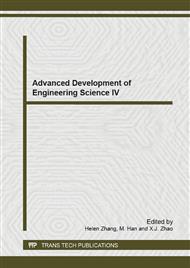[1]
Wang Zeshan, Zhang Lihua, Cao Maoxin. Dispose and Recycle of Waste Explosive[M]. Beijing: National Defence Industry Press, (1999).
Google Scholar
[2]
China North Chemical Industry Corporation. Explosives Technology Status and Development[M]. Beijing: Chemical Industry Press, (1995).
Google Scholar
[3]
Zhang Lihua. The State of Approach to Disposal and Utilization of Obsolete Explosives and Propellants, Chinese Journal of Explosives & Propellants, 1998, (1): 47-50.
Google Scholar
[4]
Ou Yu-xiang. Explosive science[M]. Beijing: Beijing Institute of Technology Press, (2006).
Google Scholar
[5]
Fu Rong, Fan Qingqing, Luo Yatian, et al. The Present Disposing Situation of Obsolete Explosives and Propellants at Home and Abroad, Sichuan Chemical Industry, 2009, 12(1): 23-25.
Google Scholar
[6]
Arthur F. Spencer, David F. Hartline. Recovery of Secondary Explosive from Explosive Composition: US, 5977354[P]. 1999-11-2.
Google Scholar
[7]
Kym B. Arcuri, Duane A. Goetsch, Steve J. Schmit, et al. Recovery of TNT and RDX from Bulk Composition B Explosives: US, 7423187B1[P]. 2008-9-9.
Google Scholar
[8]
Ma Junchang. Study and Application of Supercritical Carbon Dioxide on Extraction, Journal of Liaoyang Petrochemical College, 2001, 17(3): 16-19.
Google Scholar
[9]
A.C. Kumoro. Supercritical Carbon Dioxide Extraction of Andrographolide from Andrographis paniculata: Effect of the Solvent Flow Rate, Pressure, and Temperature, Chinese Journal of Chemical Engineering, 2007, 15(6).
DOI: 10.1016/s1004-9541(08)60018-x
Google Scholar
[10]
Jeffrey B. Morris. Relative Solubility of RDX and TNT in Supercritical CO2. Army Research Laboratory, 1997, 4.
Google Scholar
[11]
Jeffrey B. Morris. Separation of RDX from Composition B Via a Supercritical Fluid Extraction Process. Army Research Laboratory, 1997, 4.
Google Scholar
[12]
He Weiqiang. Study on B Explosives Extracted with Supercritical Fluid Method, Initiators & Pyrotechnics, 2010, (6): 50-53.
Google Scholar
[13]
WANG Baoguo, He Wei-qiang, ZHANG Jinlin, et al. Recycle and Attribute of TNT and RDX from discarded or obsolete TNT/RDX/Al, Conference Proceedins Papers of Dangerous Material and Related Safe Process Technology, (2012).
DOI: 10.4028/www.scientific.net/amr.1046.68
Google Scholar
[14]
Xu Sankui, Li Limin, Li Rui, at al. Preparation of Ru/C Catalysts by Supercritical CO2 Deposition, Rare Metal Materials and Engineering, 2011, 40(12): 2142-2146.
Google Scholar


